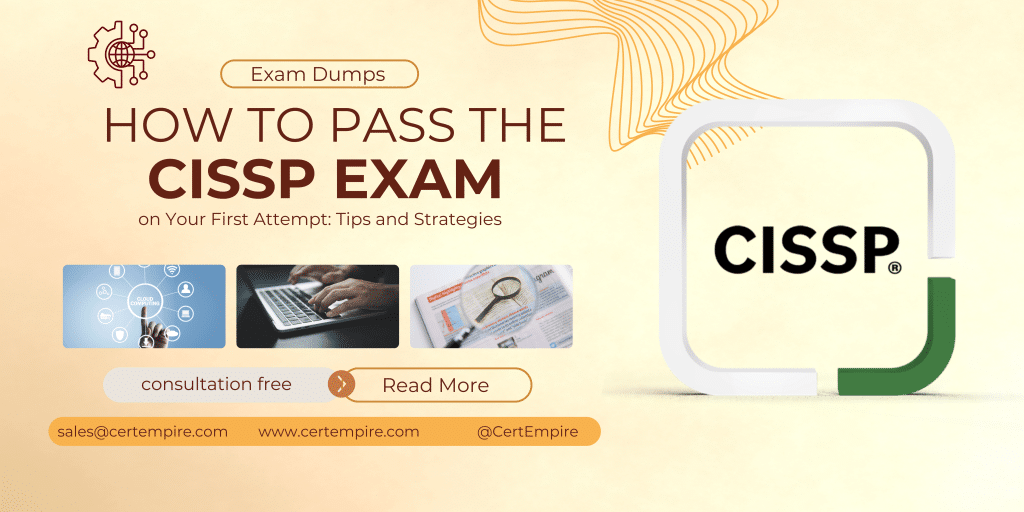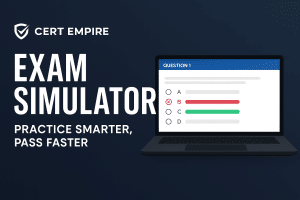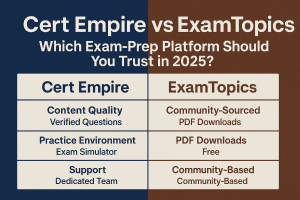The CISSP exam is known for its difficulty and comprehensive coverage of cybersecurity topics. With eight broad domains and complex scenarios, it’s no wonder that many candidates find it challenging. However, passing the CISSP exam on your first attempt is entirely possible with the right preparation, strategy, and mindset.
In this blog, we’ll share the top tips and strategies that will help you pass the CISSP exam on your first attempt. Whether you’re just starting your preparation or in the final stages, these insights will guide you through your study process, reduce your stress, and increase your chances of success.
TLDR: Too Long; Didn’t Read
To pass the CISSP exam on your first attempt, focus on understanding core concepts across all eight domains, use practice exams to assess your knowledge, manage your study time effectively, and familiarize yourself with the question format. Stay calm, stay consistent with your study plan, and review your mistakes to improve.
Why Is the CISSP Exam So Challenging?
The CISSP exam tests a wide range of skills across multiple cybersecurity domains, making it one of the most challenging certifications in the industry. It requires deep knowledge in areas like security architecture, risk management, network security, and software development security. The CISSP exam is designed to test not just your technical knowledge but also your ability to apply that knowledge in real-world scenarios.
Key Challenges of the CISSP Exam:
- Breadth of Topics: The exam covers eight domains, and candidates must demonstrate competence across a wide range of topics.
- Real-World Application: The exam often presents scenario-based questions, requiring you to apply theoretical knowledge to practical situations.
- Question Complexity: The adaptive nature of the exam makes it challenging, as questions become more difficult based on your performance.
Six-Week CISSP Study Plan (First-Attempt Focus)
| Week | Core Activities | Target Outcome |
| 1–2 | Read ISC2 Official Guide; build notes on Security & Risk Management, Asset Security | Strong grasp of fundamentals |
| 3 | Cover Communication & Network Security and Security Architecture & Engineering; do 1 practice test | Mid-level domain mastery |
| 4 | Dive into IAM and Security Operations; join study group or peer discussions | Improve applied knowledge |
| 5 | Focus on Security Assessment & Testing and Software Development Security; 2 full practice exams | Identify and fix weak areas |
| 6 | Complete timed mock exams; revise all domain flashcards and key formulas | Final confidence and time management |
1. Start with a Solid Study Plan
One of the most common reasons candidates fail the CISSP exam is poor preparation. A solid study plan will give you a structured approach and ensure you cover all the material efficiently. Here’s how to create an effective study plan:
Steps to Create a Study Plan:
- Assess Your Knowledge: Identify which domains you’re already familiar with and which ones need more focus. This helps you allocate study time accordingly.
- Set Realistic Goals: Break your study into manageable chunks. Aim for 2-3 study sessions per week and gradually increase intensity as the exam approaches.
- Allocate Time Based on Domain Weights: Focus more on high-weight domains like Security and Risk Management (16%) and Communication and Network Security (13%), but don’t neglect smaller domains like Software Development Security.
- Track Your Progress: Keep track of your completed chapters and practice exam results to see how much progress you’ve made.
Why This Matters:
A structured study plan will keep you focused and organized, helping you avoid the stress of last-minute cramming. It ensures you’re prepared for all domains.
2. Use High-Quality Study Materials
When preparing for the CISSP exam, it’s essential to use high-quality study materials that are in line with the official ISC2 CISSP exam objectives. Relying on outdated or low-quality resources can lead to confusion and wasted time.
Recommended Study Materials:
- Official ISC2 CISSP Study Guide: This guide is the most reliable resource as it aligns with the exam objectives.
- CISSP Exam Practice Questions: Use practice questions from Cert Empire or Boson to familiarize yourself with the exam format and test your knowledge.
- CISSP Video Courses: Cybrary and Udemy offer comprehensive video courses that explain key concepts clearly and are helpful for visual learners.
Why This Matters:
Using up-to-date and reliable resources ensures that you’re studying the correct material and preparing in the most effective way possible.
3. Practice, Practice, Practice
One of the best ways to prepare for the CISSP exam is by doing practice exams. Practice exams help you get familiar with the exam format, test your knowledge, and improve your time management skills.
Key Benefits of Practice Exams:
- Simulate Real Exam Conditions: Practice exams help you get comfortable with the timing and question types (multiple-choice, drag-and-drop, hotspot).
- Identify Weak Areas: After each practice test, review your mistakes and focus on the areas that need more attention.
- Build Confidence: Regular practice helps you feel more confident going into the real exam.
Why This Matters:
Practice exams give you the chance to experience the exam environment without the pressure of the real test. They help you identify areas that need improvement and boost your confidence.
4. Focus on Understanding, Not Memorizing
While it’s tempting to memorize answers, CISSP is designed to test your ability to apply knowledge to real-world situations. Focus on understanding the concepts behind each domain and how they apply in practical scenarios.
How to Focus on Understanding:
- Relate Theory to Practice: Whenever studying a new concept, think about how it applies to your work or real-world cybersecurity issues.
- Understand Security Frameworks: Be familiar with common security frameworks (e.g., ISO 27001, NIST, COBIT) and understand how they relate to the CISSP domains.
- Use Study Groups: Join online study groups or forums to discuss concepts with peers and deepen your understanding.
Why This Matters:
Understanding concepts rather than rote memorization ensures that you can answer scenario-based questions effectively and accurately. This is essential for success on the CISSP exam.
5. Don’t Rush, Manage Your Time Wisely
Time management is crucial during the CISSP exam. With 125-175 questions and a time limit of up to 3 hours, it’s important to manage your time effectively and avoid rushing through questions.
Time Management Tips:
- Practice Time-Bound Questions: During practice exams, simulate the real test by setting a timer for each question.
- Don’t Get Stuck: If you’re unsure about a question, mark it and move on. You can always come back to it later if time permits.
- Allocate Time for Review: Leave some time at the end to review any flagged questions or to double-check your answers.
Why This Matters:
Effective time management ensures that you don’t run out of time during the exam, and that you can give each question the attention it deserves.
6. Stay Calm and Confident
One of the biggest challenges during the CISSP exam is maintaining your composure. It’s normal to feel anxious, but staying calm will help you think clearly and avoid mistakes.
How to Stay Calm:
- Prepare in Advance: Follow a study plan and practice consistently so that you’re not rushing to the last minute.
- Use Relaxation Techniques: Deep breathing, stretching, or short breaks can help alleviate exam stress.
- Have a Positive Mindset: Remind yourself that you’ve prepared well and are capable of succeeding.
Why This Matters:
A calm and confident mindset will help you stay focused and make better decisions during the exam.
Quick Revision Checklist (Last 7 Days)
| Day Range | Key Action | Why It Helps |
| 7–5 Days Before | Review high-weight domains and practice scenario-based questions | Reinforces critical areas |
| 4–3 Days Before | Revisit weaker topics and tricky question formats (drag-and-drop, hotspot) | Sharpens focus on weaknesses |
| 2 Days Before | Take one final full-length timed exam | Builds endurance and timing |
| 1 Day Before | Light review of notes, relax, and prepare exam-day essentials | Reduces stress and boosts recall |
Quick Summary
To pass the CISSP exam on your first attempt, create a structured study plan, use high-quality study materials, take regular practice exams, focus on understanding concepts rather than memorizing, manage your time wisely during the test, and stay calm and confident. By following these strategies, you’ll increase your chances of success.
Final Thoughts
Passing the CISSP exam on your first attempt is entirely possible with the right preparation and mindset. Stay organized, practice regularly, and focus on understanding the material rather than memorizing answers. With the proper approach, you’ll be ready to tackle the exam and earn your CISSP certification with confidence.
More Resources
For more insights into the CISSP exam and additional study tips, click here to know everything about the CISSP credential.
Explore these related blogs to help with your CISSP preparation:
- How to Maintain Your CISSP Certification: CPE Credits and Renewal Process
- CISSP Career Benefits: What Can You Expect in Terms of Salary and Job Opportunities?
Last Updated on by Team CE



























